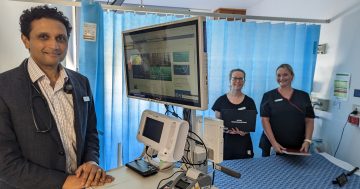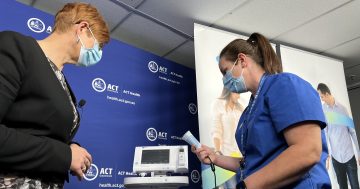
Emergency department waiting times are not improving. Photo: Region.
The performance of the ACT’s public hospitals is again being questioned after the latest Report on Government Services found waiting times in emergency departments were still the worst in the nation.
The Productivity Commission data for 2021-22 tells a now familiar story of no improvement in the Territory’s EDs, with the percentage of people seen on time stuck at 48 per cent, the same as the previous two years, despite presentations falling. The national average was 64 per cent.
Only 36 per cent of the urgent category were seen on time.
One has to go back to 2016-17 for a percentage above 50, when 62 per cent of patients were seen on time, including half of the urgent category.
The number of patients who spent four hours or less in an ED was also the lowest in the country at 52.4 per cent and has been declining for years. The year before it was 57 per cent, while in 2016-17 it was 73 per cent.
Opposition Health spokesperson Leanne Castley said the ED figures were abysmal.
“Every year the Barr-Rattenbury Government has managed the health system, it has performed worse than the national average,” she said.
“It is embarrassing and more importantly having a real impact on Canberrans’ health outcomes.”
Ms Castley said a grandmother contacted her office recently on behalf of her eight-year-old granddaughter, who waited in pain following a surgical complication for more than six hours before being seen by a doctor at the emergency department.
“Canberra families deserve access to timely care when their loved ones have to use the public health system,” she said.
Ambulance response times however were the best in the nation at 16.5 minutes for the 50th percentile and 9.9 minutes for the 90th percentile.
These times have been increasing but that would be expected with the growth of the city.
But there has been a spike in the number of ambulance officers leaving the service, pointing to mounting pressures on staff.
In 2021-22, 32 left, almost triple the number the year before (11), while in 2020-2019 14 resigned.

ACT Health Minister Rachel Stephen-Smith: still work to do. Photo: Thomas Lucraft.
Health Minister Rachel Stephen-Smith said the COVID-19 pandemic had affected ED performance but wait times would only be improved through a whole of system approach.
Ms Stephen-Smith said the ACT’s hospitals were identifying ways to improve efficiencies, patient-flow and patient discharge, and had trialled several new innovative models of care.
The 2021-22 Budget allocated $23 million to fund new programs and models of care at the Canberra Hospital, including expansion of the emergency medical unit to 18 spaces, a medical navigator and a new acute medical unit to improve the experiences of patients and ease the admissions process.
The Minister said that the ACT’s hospitals had performed better when compared against their peers across Australia for percentage of patients seen on time in the emergency department in 2021-22.
“Canberra Hospital (a public principal referral hospital) performed better than its peers in Western Australia, South Australia, Tasmania and Northern Territory. Calvary (as a public acute group A hospital) also performs better than the averages of peer hospitals in Western Australia and South Australia,” she said.
“Across all hospitals, the ACT has the second highest rate of seen on time for critical category two emergency presentations and 100 per cent of category one – resuscitation presentations seen on time. This means for the most time critical presentations, Canberrans receive some of the most timely treatment in Australia.
“However, across the other triage categories there is still work to do to improve patient flow across the hospitals and enable the emergency departments to operate more efficiently.”
Ms Stephen-Smith said the Government had found more funds in 2021-22 to minimise the impact of the pandemic on elective surgeries, part of a three-year plan to reduce the waiting list.
She said 15,831 patients were added to public hospital elective surgery waiting lists, and 16,644 people were removed from the waiting list.
“It is encouraging that our efforts to date are paying off in regard to elective surgery – the ACT is the only jurisdiction that has consistently been able to remove more patients from the elective surgery waiting list than have been added to it each year for the last five years,” she said.
Ms Stephen-Smith said more investment in primary and aged care would also make a difference and these were Commonwealth responsibilities.
“Providing more care in the community at an earlier stage of someone’s illness can prevent a person needing to present to the emergency department or be admitted into hospital,” she said.
“The ACT Government will continue to work with the Commonwealth Government to improve primary care and ensure every Canberran has access to the right healthcare, at the right time.”
The states and territories would also continue to advocate for improvements in the way the Commonwealth contributes to hospital funding, including removing the growth cap and moving towards 50:50 funding.



















